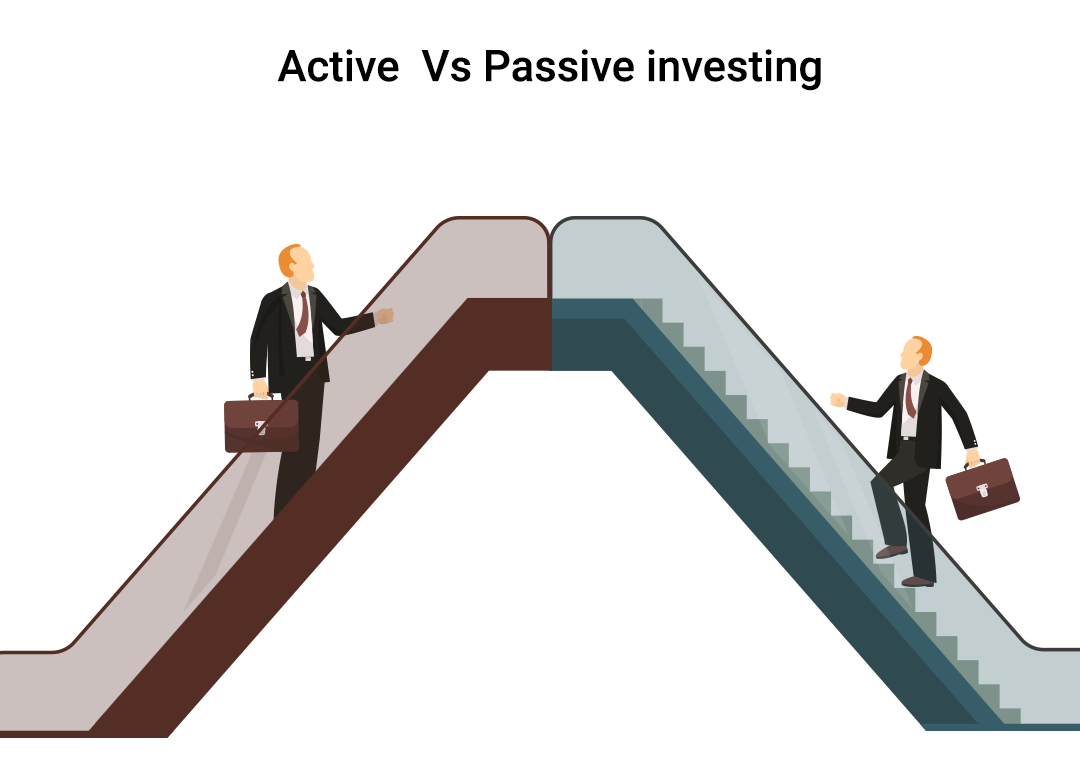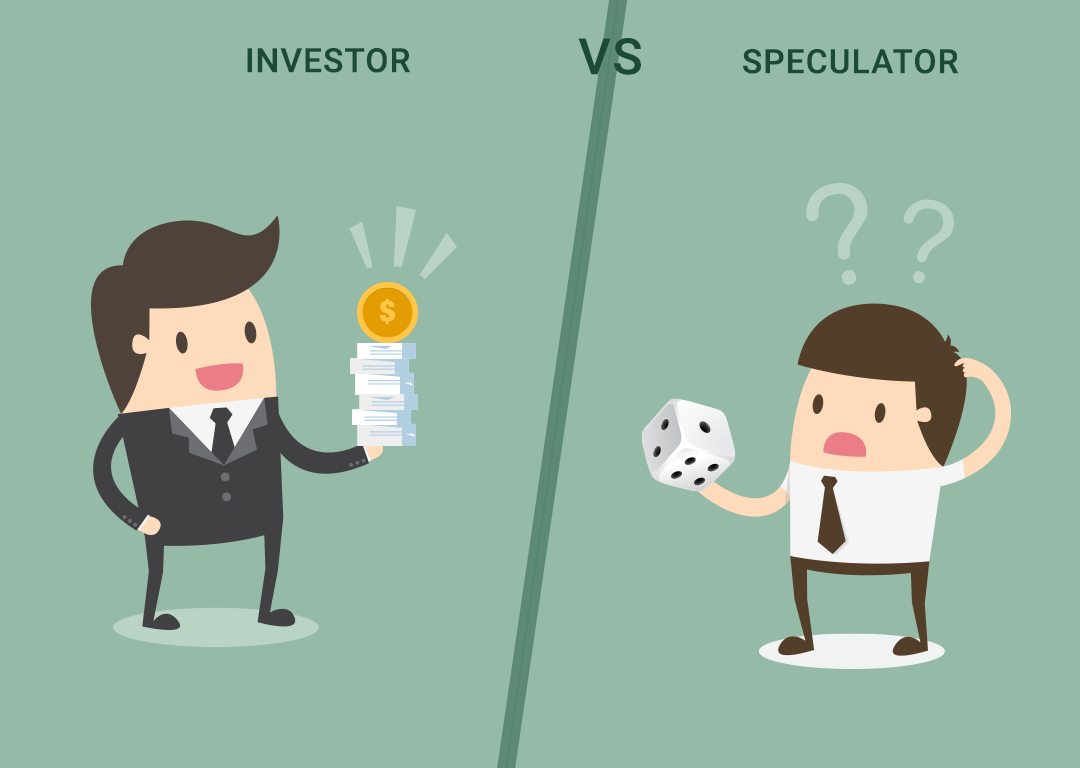What’s the difference?
In order to be a good investor, it’s important to understand the difference between the following:
Active Vs. Passive Investing

Active investing involves frequent buying and selling, as well as consistent research to handpick stocks that can outperform the market.
This strategy requires a significant time commitment and a higher tolerance for risk, making it suitable for full-time investors who are dedicated to the stock market.
Passive investing involves lower levels of buying and selling and staying with fundamentally sound companies for longer periods of time.
Passive investors typically invest in index funds or exchange-traded funds (ETFs) that track a market index. It requires less time, but it typically generates more modest returns over the long term. Passive investing is more suitable for people who have dedicated work other than investing and want to automatically grow their money over time.
Active Investing
Passive Investing
Goal is to beat the market returns by frequent buying and selling
Goal is to stay invested in fundamentally sound companies or funds
Professional money managers, traders, and individual investors who actively trade stocks
Individuals who invest in stocks, index funds, or ETFs that track broad market indices, like the S&P 500
More excitement
Less excitement
Portfolio allocation are hand-picked with less number of stocks
Portfolio is based on broader index
More Risky
Less Risky
Seek short term profit
Focus on long Term Gains
Some Facts
According to a study by S&P Dow Jones Indices, more than 90% of large-cap fund managers underperformed the S&P 500 index over the 15-year period ending in December 2020.
Monkey Vs. Professional Fund Manager
You might have heard the studies suggest that blindfolded monkey stock picking can sometimes outperform the performance of professional fund managers.
The “monkey stock picking” experiment was a simplified version of the principle of long-term passive investing.
n this experiment, an equal amount of money was invested in each stock chosen randomly by the monkey, and the performance of the overall portfolio was tracked. Monkeys chose a diversified portfolio which provided exposure to a range of companies and sectors which helped to reduce risk and volatility. It was allowed to run without further human interference over a long period of time.
It can be concluded that automated passive investments produced better returns than most of the fund manager’s portfolio.
Speculating vs. Investing
What is Speculation?

Speculation is buying or selling assets with the aim of profiting from price movements in the short term. It does not seek fundamental aspects of the company or the actual value of the asset. It is done with the anticipation of making profits quickly.
For example, when Apple Inc. was about to launch iPhone 14 in the market, many speculators bought its stocks. This was made in anticipation that once the phone is launched, its stock price will rise high.
Speculating and investing are two different approaches for positioning your money to work in the financial markets. While both involve putting money into financial vehicles in the hope of generating a return, the key difference lies in the mindset & strategy. difference
Criteria
Investing
Speculation
Definition
In-depth research and analysis of the underlying fundamentals of an asset.
Randomly selecting assets based on tips and trends
Holding Period
Long-term
Short-term
Foundation/Decision
Based on the fundamental value of asset
Based on tips, suggestions, trends, news, and market emotions.
Level of Risk
Low to moderate
High
(higher levels of volatility and uncertainty)
Return
Moderate to High (building long-term wealth)
Low to high (highly variable)
Attitude
Cautious, Conservative, Goal oriented
Greed, Aggressive, Get rich quick mindset
In order to be a good investor, it’s important to understand the difference between the following:
Active Vs. Passive Investing

Active investing involves frequent buying and selling, as well as consistent research to handpick stocks that can outperform the market.
This strategy requires a significant time commitment and a higher tolerance for risk, making it suitable for full-time investors who are dedicated to the stock market.
Passive investing involves lower levels of buying and selling and staying with fundamentally sound companies for longer periods of time.
Passive investors typically invest in index funds or exchange-traded funds (ETFs) that track a market index. It requires less time, but it typically generates more modest returns over the long term. Passive investing is more suitable for people who have dedicated work other than investing and want to automatically grow their money over time.
Active Investing |
Passive Investing |
| Goal is to beat the market returns by frequent buying and selling | Goal is to stay invested in fundamentally sound companies or funds |
| Professional money managers, traders, and individual investors who actively trade stocks | Individuals who invest in stocks, index funds, or ETFs that track broad market indices, like the S&P 500 |
| More excitement | Less excitement |
| Portfolio allocation are hand-picked with less number of stocks | Portfolio is based on broader index |
| More Risky | Less Risky |
| Seek short term profit | Focus on long Term Gains |
Some Facts
According to a study by S&P Dow Jones Indices, more than 90% of large-cap fund managers underperformed the S&P 500 index over the 15-year period ending in December 2020.
Monkey Vs. Professional Fund Manager
You might have heard the studies suggest that blindfolded monkey stock picking can sometimes outperform the performance of professional fund managers.
The “monkey stock picking” experiment was a simplified version of the principle of long-term passive investing.
n this experiment, an equal amount of money was invested in each stock chosen randomly by the monkey, and the performance of the overall portfolio was tracked. Monkeys chose a diversified portfolio which provided exposure to a range of companies and sectors which helped to reduce risk and volatility. It was allowed to run without further human interference over a long period of time.
It can be concluded that automated passive investments produced better returns than most of the fund manager’s portfolio.
Speculating vs. Investing
What is Speculation?

Speculation is buying or selling assets with the aim of profiting from price movements in the short term. It does not seek fundamental aspects of the company or the actual value of the asset. It is done with the anticipation of making profits quickly.
For example, when Apple Inc. was about to launch iPhone 14 in the market, many speculators bought its stocks. This was made in anticipation that once the phone is launched, its stock price will rise high.
Speculating and investing are two different approaches for positioning your money to work in the financial markets. While both involve putting money into financial vehicles in the hope of generating a return, the key difference lies in the mindset & strategy. difference
Criteria |
Investing |
Speculation |
| Definition | In-depth research and analysis of the underlying fundamentals of an asset.
|
Randomly selecting assets based on tips and trends |
| Holding Period | Long-term | Short-term |
| Foundation/Decision | Based on the fundamental value of asset | Based on tips, suggestions, trends, news, and market emotions. |
| Level of Risk | Low to moderate | High
(higher levels of volatility and uncertainty) |
| Return | Moderate to High (building long-term wealth) | Low to high (highly variable) |
| Attitude | Cautious, Conservative, Goal oriented | Greed, Aggressive, Get rich quick mindset |
